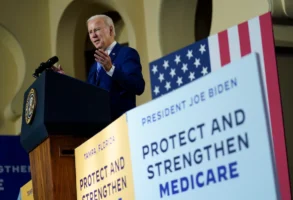
Published April 8, 2019
Virtually all polls of the Democratic presidential race have former vice president Joe Biden and Vermont Sen. Bernie Sanders running one-two. Underneath those top-line results, however, polls show Democrats are sharply divided by age and ideology — divisions that will likely shape the outcome of the race.
The most obvious division among Democratic voters is age. Younger voters are much likelier to back Sanders, or perhaps it’s more accurate to say that older voters are extremely unlikely to back him. Both national and state polls in Iowa and New Hampshire show Sanders wins handily among voters under 45 years old, with his support most heavily concentrated among those under 30 or 35. His support tails off dramatically, however, the older the voter gets. Among the oldest group — those older than 65 — he barely polls above 10 percent, polling as low as 8 percent among those 45 and older in a national CNN poll.
Biden’s support is the mirror opposite. He gets his largest support among the oldest group of voters, dropping off the younger the voter gets and doing worst among the youngest set. He doesn’t do quite as poorly in the national polls among the young as Sanders does among the elderly — the worst Biden gets is 19 percent in that same CNN poll. But it’s still interesting how two men in their late 70s attract very different age groups of voters.
A lot of this is likely explained when one looks at voter ideology. The two men’s backers sharply diverge here as well. Biden’s support is always stronger among moderates than among liberals; it’s the reverse with Sanders. Splice liberals further into “very liberals” and “somewhat liberals,” and the divide widens. The most recent Quinnipiac poll shows Biden receiving only 14 percent of very liberal voters, with his support rising to 26 percent among somewhat liberals and topping out at 37 percent among moderates. Sanders does about as well among very liberals (21 percent) as somewhat liberals (23 percent) but then drops off slightly among moderates (15 percent).
We should probably assume there is a fair bit of overlap among these groups. Older moderates and liberals are backing Biden, while younger progressives and liberals are backing Sanders. But that leaves a lot of people out. Whom are the younger moderates and liberals backing? Whom are the older progressives backing? Since Biden and Sanders combined normally get only about half the Democratic vote, that leaves a lot of potential voters up for grabs.
Older progressives and liberals tend to be supporting Sen. Kamala D. Harris (Calif.), with some backing Sen. Elizabeth Warren (Mass.). Harris’s support base always tilts leftward; she runs better among liberals than moderates in all five national and state polls that ask a voter’s ideology. In the Quinnipiac poll, that tendency was stronger still, as she ran best among very liberals (15 percent), received less support from somewhat liberals (10 percent) and performed worst among moderates (5 percent). That’s a pattern that looks more like Sanders’s than Biden’s, suggesting that either she could get Sanders’ votes should he falter or he could get hers should he prevail.
But her voters also trend older than his do. She does better among voters over 45 than those under in three of the four national polls, and in the Emerson poll, her age profile perfectly mirrors Biden’s in that the older the voter gets, the higher her support. In fact, Harris, not Sanders, runs second to Biden among voters 65 and older in that poll. This raises a big question: If she has to drop out, what will be a more important factor for her voters — their ideology, which tilts them toward Sanders, or their age, which tilts them toward Biden?
Beto O’Rourke’s voters have the opposite problem of Harris’s — they are younger moderates. He does better among voters under 45 in two of the four national polls and does equally well with both age groups in the other two. In two national polls, his ideological support is roughly balanced while in the Quinnipiac poll, it follows Biden’s pattern, getting stronger the less liberal the voter is. His voters, then, will face the same challenge as Harris’s should he exit the race. Will their ideology, which tilts them toward Biden, be more a more important factor than their age, which tilts them toward Sanders?
Warren’s voters are the closest match for the Sanders cohort. They are also quite liberal, tilting more to the left in both national and state polls than do Sanders’s. They are more balanced in terms of age than Sanders voters, but they also tilt toward the under-45 side. Should she drop out, her voters are likelier to back Sanders over Biden on both ideological and age grounds.
The first votes won’t be cast for 10 months, but some of the underlying factors that will help determine the Democratic race’s outcome are already apparent. Watch how candidates fare among age and ideological cohorts, and you will have a good early look at both the trends and the chance a surging candidate has to pick up further votes — and from whom.
Henry Olsen is a Washington Post columnist and a senior fellow at the Ethics and Public Policy Center.





